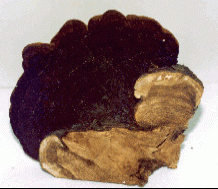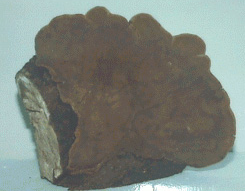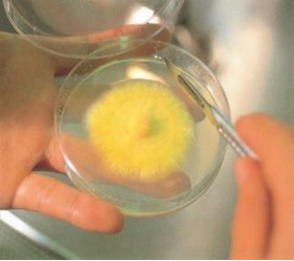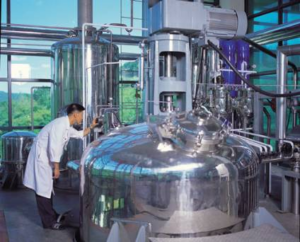What is Sanghwang (Phellinus linteus)?
Sanghwang, known scientifically as Phellinus linteus (Berk. et Curt) Aoshima, is a medicinal fungus classified under Basidiomycetes. It belongs to the order Aphylloporales, family Hymenochaetaceae, and the genus Phellinus.
It primarily grows on mulberry trees but can also be found on maple, alder, birch, cherry, and oak trees.
Over the years, it has been referred to by various scientific names, including P. igniarius, P. yucatensis, Fomes yucatensis, and Pyropolyporus yucatensis.
Despite differing opinions among scholars, the name “Sanghwang” is widely accepted in both academic and traditional medicine contexts.
Historical Names and Classification
Sanghwang has been documented in various classical Chinese and Korean medicinal texts under multiple names.
For example:
- Shennong Bencao Jing (神農本草經): Sang-i (桑耳)
- Tang Dynasty’s “Yao Xing Lun” (藥性論): Sanghwang (桑黃), Sangsin (桑臣)
- Youyang Zazu (酉陽雜俎): Hosonan (胡孫眼)
- Chanyo Gibang (纂要奇方): Sanghwang-go (桑黃枯)
- Bonchogangmok (本草綱目) by Li Shizhen: Sang-i (桑耳), Sanghwang (桑黃)
- Dongui Bogam (東醫寶鑑) by Heo Jun: Sang-i (桑耳), Sanghwang (桑黃)

According to the Zhongyao Dacidian (中藥大辭典), Sanghwang also grows on willow, paper mulberry, elm, and is referred to by names like Sangsin, Sang-i, Sanghwang-go, and Hosonan.
However, the book Chinese Medicinal Fungi (中國藥用真菌, 1978) by Liu Bo argues that true Sanghwang refers only to fungi found on mulberry trees, with the correct name being Pyropolyporus yucatensis Murr.
The Meaning Behind “Mesima”
In Japanese mycological literature, such as Kawamura Seiichi’s Illustrated Mycology of Japan and Imaseki Rokuya’s New Illustrated Guide to Japanese Fungi, the term “Mesimakofu” is used to describe Phellinus linteus.
This term refers to a mushroom that grows primarily on mulberry trees, with its yellowish body color (excluding the cap surface) inspiring the name “Sanghwang” (桑黃).
Therefore, the name Phellinus igniarius is not the true designation for Sanghwang; it is considered a broader genus-level name.
The academically accepted name for true Sanghwang is Phellinus linteus (Berk. et Curt) Aoshima.
Mycelial Cultivation
Technology of Sanghwang
Korea New Pharmaceuticals has focused on optimizing the culture conditions for the Phellinus linteus strain to enable efficient scale-up and stable production of high-quality bioactive substances.
Sanghwang is an extremely rare fungus in nature. Its fruiting body is difficult to obtain, and isolating and cultivating its mycelium artificially has proven to be technically challenging.
While there have been reports of successful artificial cultivation of the fruiting body, the authenticity and consistency of such efforts remain questionable.
Phellinus linteus (Berk. et Curt) Aoshima


The Phellinus linteus Yoo mycelium strain has been genetically analyzed to confirm its ability to produce potent anticancer and immune-enhancing bioactive substances.
Challenges of Cultivating
Sanghwang Mycelium

In 1968, Japan’s National Cancer Center reported Sanghwang’s impressive medicinal effects, but further research was abandoned due to the rarity of its fruiting body and the technical difficulty of large-scale mycelial cultivation.
Natural cultivation of Sanghwang can take several years or even decades.
Need for
Mass Production Innovation
The Phellinus linteus Yoo mycelium is scientifically recognized as a key source of high-efficacy compounds used in Mesima’s immunotherapeutic applications.
Although Sanghwang’s anticancer and immunomodulatory effects are already well documented, industrial-level production technology has been lacking both in Korea and globally.
This made it crucial to develop a reliable and scalable manufacturing process.
In 1991, Korea New Pharmaceuticals succeeded in developing “Mesima” by cultivating a highly active strain of Phellinus linteus through both solid and liquid fermentation.
Artificial cultivation requires precise environmental control — including temperature, humidity, and nutrients — and a contamination-free environment, particularly during the early stages.
Large-Scale Fermentation
Using 12-Ton Bioreactors
Through a decade-long collaboration with Dr. Ik-Dong Yoo’s team at KRIBB under the G7 National Biotechnology Project, Korea New Pharmaceuticals became the first in the world to successfully mass-cultivate Sanghwang mycelium with verified anticancer and immune-boosting activity.
he most potent strain, Phellinus linteus Yoo, was isolated and optimized during this project.

Patent on
Sanghwang Mycelium Strain
Dr. Ik-Dong Yoo’s team at KRIBB conducted a genetic analysis to verify the bioactivity and authenticity of the mycelial strain, resulting in the isolation and patenting of the high-performing Phellinus linteus Yoo strain.
This discovery enabled stable, large-scale production of mycelium rich in anticancer and immunomodulatory compounds.
From Research to Commercialization
Dr. Yoo later founded a dedicated research institute within Korea New Pharmaceuticals, further advancing the Mesima platform through continuous innovation and strain development.
Using the patented strain and proven scale-up methods, Korea New Pharmaceuticals secured regulatory approval from the Ministry of Food and Drug Safety (MFDS) of Korea.
Toward the
Next Generation of Mesima
he selected strain has been refined based on its ability to grow consistently under large-scale fermentation and its high yield of bioactive compounds.
Mesima continues to evolve through new research, with a focus on even greater efficacy and purity.
The Core of Mesima
Phellinus linteus Yoo
Genomic Profiling of Mesima Producing Powerful Anticancer and Immunomodulatory Compounds

Genetic Analysis of Mesima
(Presented at the 2001 Annual Meeting of the Japanese Society of Pharmacognosy)
The genetic sequencing and pharmacological properties of Phellinus linteus Yoo were presented at the 2001 Annual Meeting of the Japanese Society of Pharmacognosy.
This strain represents the scientific foundation and therapeutic excellence behind the global reputation of Mesima.
